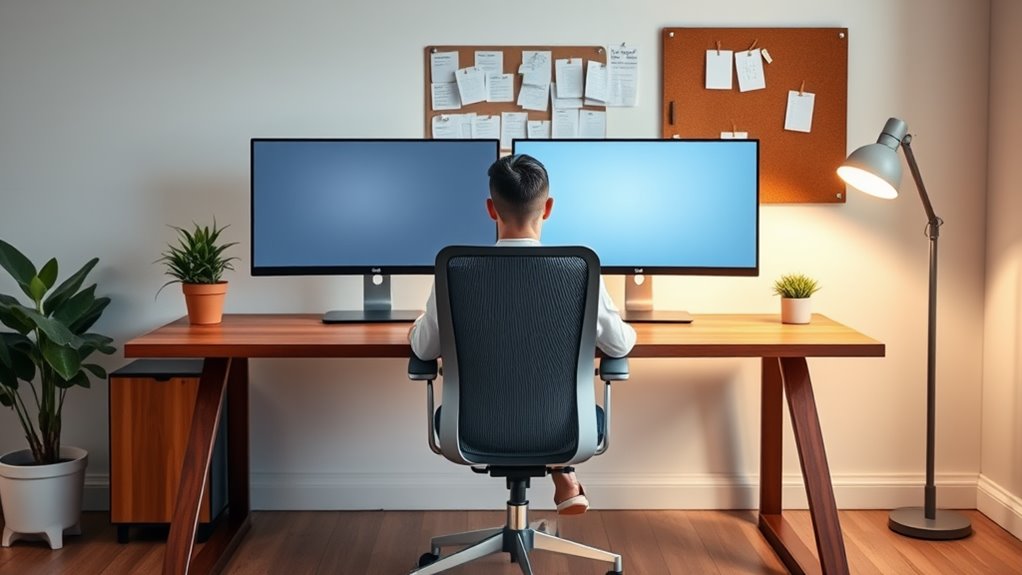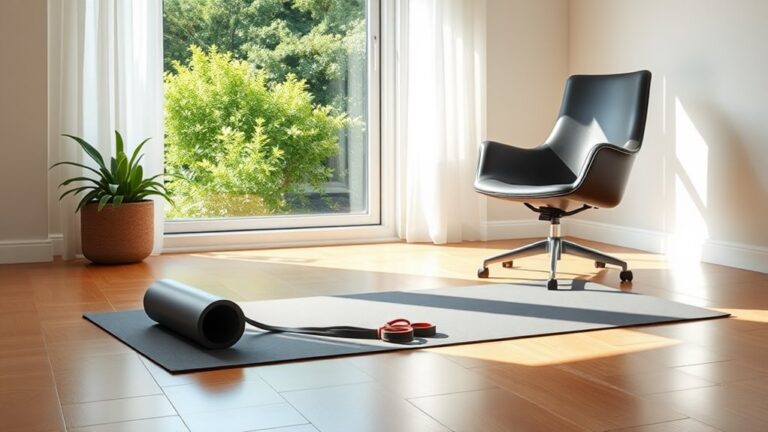An ideal ergonomic work setup hinges on understanding the interplay of chair selection, desk height, and monitor placement. Proper chair support maintains spinal alignment, while the correct desk height promotes an advantageous elbow angle. Positioning your monitor at eye level minimizes neck strain and reduces eye strain. Incorporating accessories such as adjustable desks and supportive trays enhances comfort and productivity. By implementing these practices, you can protect your health and efficiency. Discover more about perfecting your workspace.
Nomad Highlights
- Ergonomics minimizes discomfort and enhances productivity by promoting proper posture and reducing the risk of workplace injuries.
- Desk height affects elbow angle; an ideal setup prevents slouching and encourages healthy spinal alignment.
- Monitor positioning at or slightly below eye level reduces neck strain and eye fatigue while allowing for comfortable viewing.
- Incorporating tools like adjustable desks and ergonomic chairs supports alignment and circulation, enhancing overall comfort.
- Regular adjustments and movement breaks are essential for maintaining an ergonomic workspace and preventing musculoskeletal disorders.
Understanding Ergonomics: The Basics
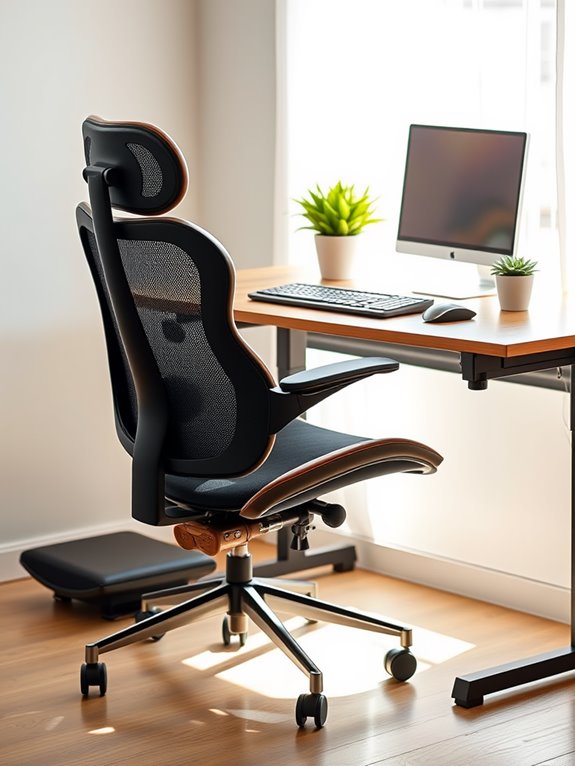
Understanding ergonomics is essential for creating a workspace that minimizes discomfort and enhances productivity. By applying ergonomic principles, you can design an environment that promotes workplace health and reduces the risk of injury.
Start by evaluating your workspace layout. Make sure that your monitor is at eye level to prevent neck strain and position your keyboard at a comfortable height to avoid wrist issues. Consider the arrangement of tools and materials, keeping frequently used items within easy reach to minimize excessive stretching. Using ergonomic wrist rests can provide additional support for your wrists during prolonged typing sessions. Additionally, incorporating portable lapstands can help achieve a more comfortable working position when using laptops on the go. Incorporating adjustable lumbar support in your chair can further enhance overall comfort and posture.
Incorporate adjustable furniture to accommodate various body types, encouraging proper posture. Additionally, using adjustable footrests can improve blood flow and alleviate discomfort during long periods of sitting. Finally, take regular breaks to alleviate muscle tension and enhance focus. Additionally, choosing ergonomic chairs with adjustable features can significantly improve your comfort during long hours of work.
The Importance of Chair Selection
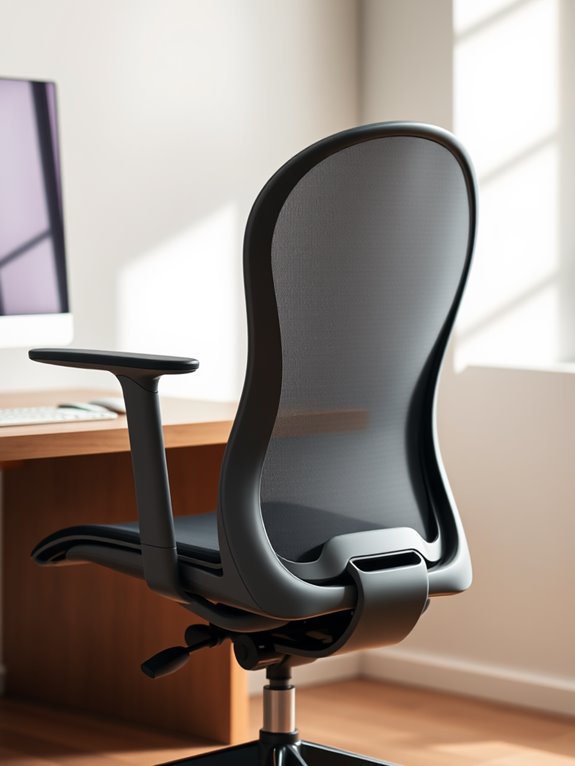
Choosing the right chair is essential for maintaining comfort and productivity during long hours at your desk.
An innovative chair can greatly enhance your work experience if you consider these key factors:
- Chair Materials: Look for breathable fabrics that promote airflow, reducing heat buildup. Additionally, selecting eye protection features in your lighting setup can further enhance comfort during extended work sessions. A chair made from energy-efficient materials can also contribute to a sustainable workspace. Moreover, opting for a chair with quiet operation can create a more peaceful working environment. Consider the chair’s ergonomic design to promote better posture and reduce strain over time.
- Lumbar Support: Verify the chair offers adjustable lumbar support to maintain the natural curve of your spine.
- Adjustability: Opt for a chair with customizable height, armrests, and backrest angles, allowing you to find your ideal position.
- Mobility: Choose a chair with smooth-rolling casters and a swivel base to enhance your workspace efficiency. Additionally, ensure that your workspace setup, including ergonomic mice, complements your chair selection for optimal comfort and performance.
Desk Height and Its Impact on Posture
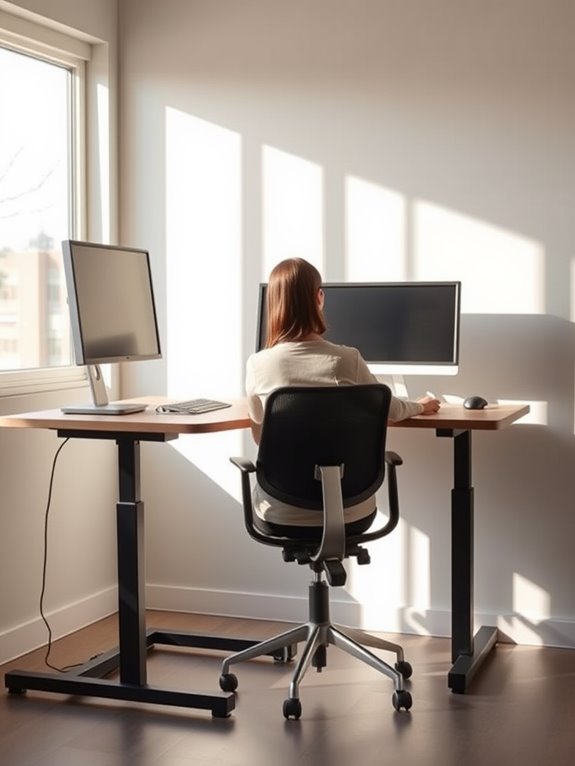
While many people overlook desk height, it plays an essential role in maintaining proper posture and reducing strain during long hours of work.
A suitable desk measurement guarantees that your elbows remain at a 90-degree angle, which promotes comfort and stability. When your desk is too high or too low, you’re likely to slouch or overextend, leading to poor posture and potential long-term injuries. Adjusting your desk height can be complemented by using a height-adjustable stand, which allows for personalized ergonomic adjustments. Regularly adjusting your desk height can also lead to improved blood circulation, enhancing overall comfort during work. Incorporating an ergonomic setup can also help prevent musculoskeletal disorders that arise from prolonged poor posture. Additionally, a space-efficient design in your workspace can contribute to a more organized and conducive work environment.
By adjusting your desk height to facilitate posture correction, you align your body in a neutral position, reducing unnecessary stress on your back and shoulders.
Consider using a height-adjustable desk to achieve this flexibility. Investing time in the right desk height can greatly enhance your work experience and overall well-being. Additionally, incorporating an ergonomic lapstand can further improve your posture and reduce discomfort during laptop use.
Monitor Placement for Optimal Eye Health
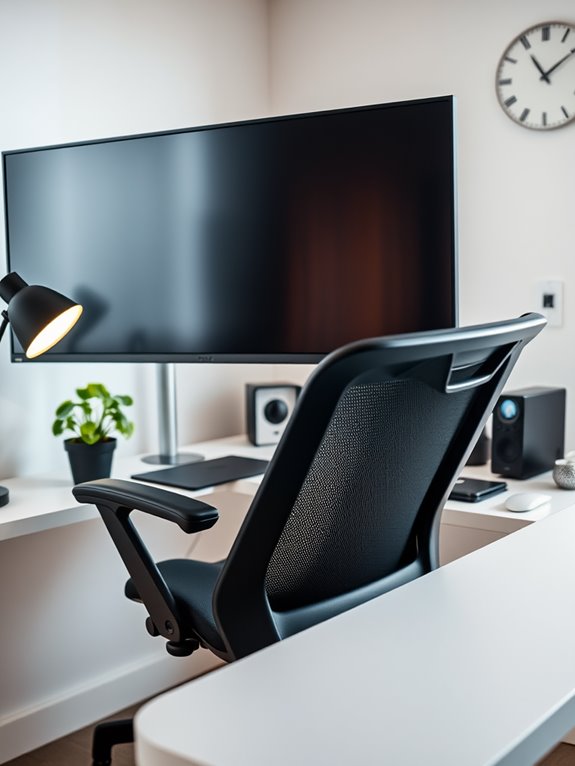
To promote ideal eye health, position your monitor so that the top of the screen is at or slightly below eye level, which helps reduce strain.
Maintain a distance of about an arm’s length from your eyes to minimize discomfort. Additionally, adjust your monitor to minimize glare from windows or overhead lights, enhancing your visual comfort during long work sessions. Furthermore, consider using a lumbar support cushion to maintain proper posture while seated, as this can contribute to overall body alignment and reduce strain during extended periods of sitting. Incorporating health monitoring capabilities into your work routine, such as using a fitness tracker, can also help promote overall wellness and remind you to take necessary breaks. Regularly checking your heart rate and blood pressure can provide insight into your physical well-being, helping to ensure you are not overexerting yourself during work hours. Using ankle resistance bands during breaks can also enhance your leg strength and stability, contributing to better posture and overall health. Additionally, maintaining proper ergonomic setup ensures that your workspace promotes comfort and reduces the risk of strain-related injuries.
Eye Level Alignment
Proper monitor placement is essential for maintaining ideal eye health, as it directly influences your comfort and productivity.
Aligning your monitor at eye level can greatly reduce eye strain and enhance visual comfort. Here are some key considerations:
- Make sure the top of the screen is at or slightly below your eye level.
- Position the monitor about an arm’s length away.
- Tilt the monitor slightly backward (10-20 degrees) to minimize glare.
- Adjust brightness and contrast settings to suit your environment. Additionally, consider using an ergonomic lapstand that allows for customizable height adjustments to further enhance your setup.
Incorporating nutrient-dense snacks such as mixed nuts can provide sustained energy and improve focus during long work hours.
Distance From Eyes
Achieving the right distance from your eyes to the monitor can greatly impact your visual comfort and overall eye health. The ideal screen distance typically ranges from 20 to 30 inches, depending on your screen size and resolution. This distance minimizes eye strain by allowing your eyes to focus comfortably while maintaining clarity.
You’ll want to guarantee that the top of the screen is at or just below eye level, which helps maintain a neutral head position. Additionally, adjusting the monitor’s brightness and text size can further enhance visual comfort at this distance. Investing in an ergonomic design, such as an ergonomic monitor stand, can also help maintain optimal viewing angles and reduce discomfort. Moreover, much like the importance of data security in project management apps, regularly reassessing your screen placement can foster an innovative work environment, ultimately contributing to increased productivity and reduced fatigue. Prioritize your eye health by optimizing your monitor’s position. Furthermore, utilizing a portable standing desk converter can significantly improve your overall workspace ergonomics and comfort.
Reducing Glare Effects
While glare can greatly hinder your visual comfort and productivity, careful monitor placement can mitigate its effects.
To enhance your eye health, consider the following strategies:
- Position Your Monitor: Place your screen about an arm’s length away, slightly below eye level.
- Adjust Lighting: Use indirect lighting to reduce reflections from windows or overhead lights.
- Utilize Glare Filters: Invest in glare filters to minimize harsh light on your screen. An effective option could be using anti-glare screen protectors that can reduce reflections and enhance visibility. Additionally, implementing privacy filters not only helps reduce glare but also protects sensitive information from prying eyes.
- Opt for Screen Coatings: Choose monitors with anti-glare screen coatings that diffuse light, enhancing clarity. Additionally, using privacy screens can further protect your eyes by reducing glare and filtering out harmful blue light. This is particularly important as blue light blocking glasses can help reduce eye strain during prolonged screen use. Furthermore, ensuring your monitor is placed at an optimal distance can prevent eye strain issues that arise from excessive screen time.
Accessories That Enhance Ergonomics
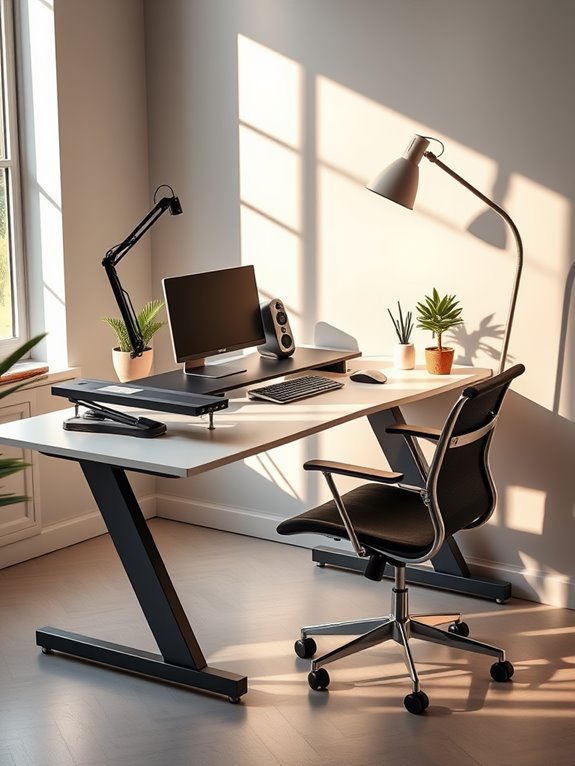
To optimize your ergonomic setup, consider incorporating essential tools designed for adjustability and comfort.
Accessories like ergonomic chairs, adjustable desks, and supportive keyboard trays can considerably reduce strain during long work hours. Additionally, integrating blue light blocking glasses into your routine can help alleviate eye strain and enhance comfort while working on screens. Choosing materials with breathability and comfort will further enhance your work experience. Evaluating these tools will help you create a workspace that promotes better posture and enhances overall productivity. Incorporating adjustable tablet stands into your setup can provide versatile designs that accommodate a range of devices and uses. Furthermore, using polycarbonate lenses in your blue light blocking glasses can significantly improve visual clarity and comfort during extended screen time. Utilizing ergonomic designs in your accessories can help minimize muscle strain and promote a healthier work environment.
Essential Ergonomic Tools
Integrating essential ergonomic tools into your workspace can greatly enhance comfort and productivity.
By selecting the right accessories, you can create an environment that minimizes strain and maximizes efficiency.
Consider incorporating the following tools:
- Standing Desks: Allow you to alternate between sitting and standing, promoting better posture and circulation.
- Keyboard Trays: Help position your keyboard at a comfortable height, reducing wrist strain.
- Monitor Stands: Elevate your screen to eye level, preventing neck and shoulder discomfort.
- Ergonomic Chairs: Support your lumbar region and encourage proper alignment during long hours of sitting.
Implement these innovative tools to revolutionize your workspace and foster a healthier, more productive work experience.
Adjustability and Comfort
Adjustability is a key factor in enhancing comfort and ergonomics in your workspace, as it allows you to customize your setup according to your specific needs.
By incorporating accessories that offer ergonomic flexibility, you can greatly improve your productivity and well-being. For instance, adjustable desks enable you to alternate between sitting and standing, promoting better posture and circulation.
Similarly, customizable chair features, like lumbar support and seat height, enhance comfort customization, allowing you to find the perfect fit.
Additionally, monitor stands that adjust to eye level help reduce strain on your neck and eyes.
Prioritizing these adjustable components not only fosters a healthier workspace but also encourages a more dynamic and innovative approach to your daily tasks.
Tips for Maintaining an Ergonomic Workspace
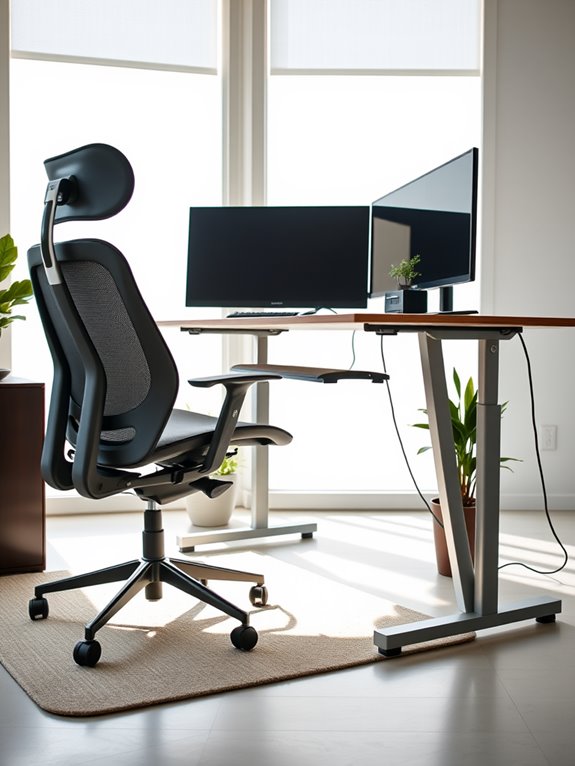
While you may think that setting up an ergonomic workspace is a one-time task, maintaining it requires ongoing attention and adjustments.
To guarantee your workspace remains efficient and conducive to comfort, consider these practical tips:
- Adjust regularly: Revisit your chair height, desk level, and monitor position every few weeks for ideal alignment.
- Incorporate movement breaks: Stand, stretch, or walk every hour to reduce fatigue and enhance circulation.
- Reassess workspace organization: Keep essential items within reach to minimize strain and promote efficiency.
- Evaluate posture: Check your sitting position frequently to guarantee your back is supported and your feet are flat on the ground.
Frequently Asked Questions
What Are the Signs of Poor Ergonomic Setup?
If you’re experiencing pain symptoms like neck stiffness, back pain, or wrist discomfort, it’s likely your workspace layout is contributing to these issues.
You might notice your screen’s too low, your chair’s not supportive, or your keyboard’s at an awkward angle. These factors can lead to fatigue and decreased productivity.
Evaluating your setup can help you identify these signs early, allowing for adjustments that promote comfort and efficiency in your work environment.
How Often Should I Adjust My Workspace?
Research shows that 80% of workers experience discomfort due to poor workspace setup.
You should adjust your workspace regularly to maintain ideal posture awareness and guarantee workspace flexibility. Aim to make adjustments every hour, especially if you notice strain or fatigue.
Incorporating small changes, like repositioning your monitor or chair, can greatly enhance your comfort and productivity.
Can I Improve Ergonomics on a Budget?
Absolutely, you can improve ergonomics on a budget!
Start with budget-friendly solutions like using a cushion for lumbar support or a rolled towel to enhance your chair’s comfort.
Consider DIY adjustments, such as repurposing boxes to raise your monitor to eye level.
Simple changes, like adjusting your seating position or keyboard height, can greatly reduce strain.
Innovatively rethinking your workspace allows you to create a healthier environment without breaking the bank.
Are Standing Desks Better for Posture?
Studies show that using standing desks can reduce back pain by up to 32%.
If you’re looking to improve your posture, standing desk benefits are significant. They encourage natural posture correction, helping to align your spine and reduce the strain caused by prolonged sitting.
By alternating between sitting and standing, you can enhance comfort and productivity.
Investing in a standing desk might just be the innovative change your workspace needs for better health.
How Does Lighting Affect My Ergonomic Setup?
Lighting plays an essential role in your ergonomic setup. The right lighting intensity can reduce eye strain and enhance focus, preventing fatigue during long hours.
Natural light is particularly beneficial; it boosts mood and productivity, making you feel more energized. Conversely, inadequate or harsh lighting can lead to poor posture as you lean in to see better.
Make sure your workspace has adjustable lighting options to maintain comfort and support your health effectively.
Conclusion
In summary, optimizing your ergonomic workspace isn’t just about comfort; it’s a pivotal step towards enhancing your overall health and productivity. As you adjust your chair, desk, and monitor, ask yourself: are you truly maximizing your setup? With small tweaks, you could reveal significant improvements in your well-being. Don’t underestimate the power of a well-designed environment—it may just be the key to preventing long-term issues. Are you ready to make that change?

